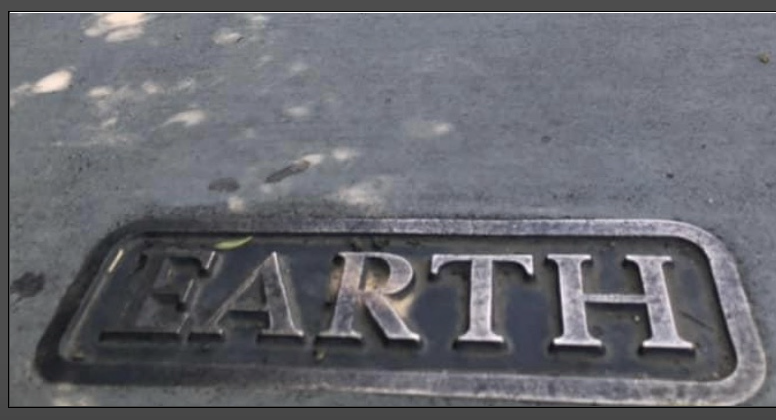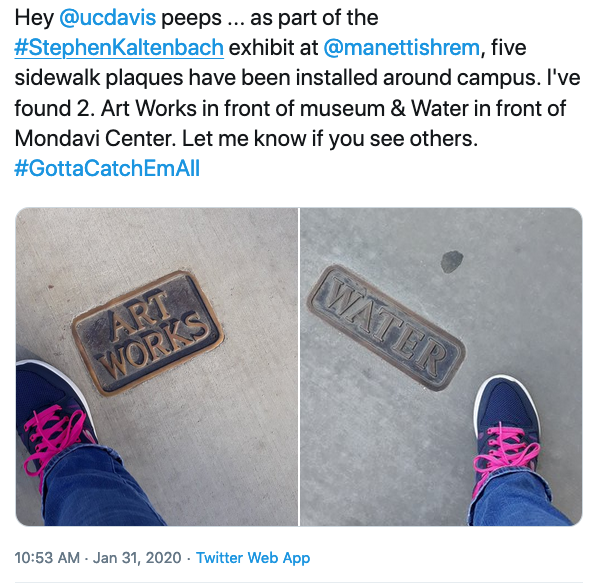Original article by Leigh Houck, UC Davis News and Media Relations Intern, who is now a doctoral student in Spanish at UC Davis.
(Unexpected Art is one in a series of stories written about art in unexpected places. This is an update of a piece published in 2000.)
You don’t have to enter a museum, library or lecture hall to come across unexpected art on the UC Davis campus. You just have to walk around. If you’ve noticed words emblazoned in cement walkways on campus, you may know what I’m talking about.
Now, five of these bronze plaques are embedded in various sidewalks around campus. There are no explanatory labels. There is no map or guide. You just have to find them.
The words originate with Stephen Kaltenbach, a renowned conceptual artist and UC Davis alumnus whose work was on exhibition in early 2020 at the Jan Shrem and Maria Manetti Shrem Museum of Art before COVID-forced closures in March 2020. He was inspired by the municipal signage he encountered when he lived in New York, and in 1968 created a series of eight Sidewalk Plaques intended to be installed in public places.
“The lack of information could make them invisible to you,” Kaltenbach said during the Jan. 26 exhibition opening at the museum. “You could actually be a guy delivering a pizza or something and not be interested in art and you could walk by a plaque in the sidewalk that said FIRE and it could be urban nature.”
The idea is that they are not on display, in the traditional sense that public art is, such as a sculpture on a plateau, or a mural on a wall. The casual observer just happens upon them.
“I decided to do a series of plaques that anyone would recognize as a natural, so I did a series of BLOOD, SKIN and BONE. Even though you can see all that stuff on the streets of New York, more than you want in some cases, it would be something that would not fit into your idea of what would be natural.” — Kaltenbach
Now, five of these bronze plaques are embedded on various sidewalks around campus. There are no explanatory labels. There is no map or guide. You just have to find them.
Here's a recent social media post from writer and communications specialist Kathleen Holder, of the College of Letters and Science, commenting on the works.


Hints to find them
Here are some hints. First of all, they all lead to TB-9, the iconic structure on campus where art was not only created by Kaltenbach when he studied here, but is created each day still today by art students and faculty.
One of these plaques, entitled ART WORKS, is installed near the Manetti Shrem Museum. The other plaques displayed on sidewalks throughout campus are labeled EARTH, WATER, FIRE and AIR.
Members of the community have started to find these unexpected pieces of art, and they were again recently a subject of social media by UC Davis staff. Can you find them?
The entire Sidewalk Plaques series, including four additional Kaltenbach plaques, were to be on display in museum’s galleries during the exhibition that was cut short in 2020.
“I decided to do a series of plaques that anyone would recognize as a natural, so I did a series of BLOOD, SKIN and BONE,” Kaltenbach explained. “Even though you can see all that stuff on the streets of New York, more than you want in some cases, it would be something that would not fit into your idea of what would be natural.”
Below is one example of a social media post from 2020.

The Manetti Shrem Museum launched “Stephen Kaltenbach: The Beginning and The End” on Jan. 26, 2020, but cut the exhibit short due to COVID closures in March.
Laura Compton, communications specialist at the Manetti Shrem Museum, contributed to this piece.
Media Resources
Media contact: Karen Nikos-Rose, 530-219-5472, kmnikos@ucdavis.edu
